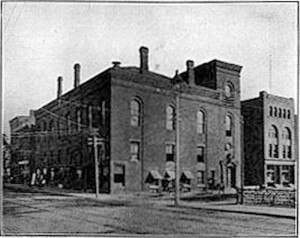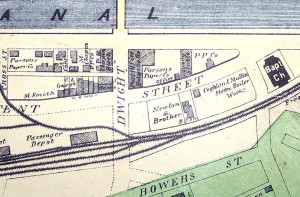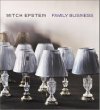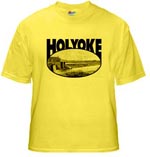by Laurel | May 19th, 2010
May 19, 1901
Chapin-Parsons Hall History
Few who attended the opening dance at the bazaar of Uncas tribe of Red Men in their new wigwam in the Parsons building were perhaps aware that this old hall, brightened with fresh paint and new paper and gay with bunting and flags was in former days town hall, dance hall, meeting place for struggling religious societies, rallying place for the soldiery of the days of ’61 and finally a paper storage warehouse, not to mention a dozen other uses that the hall has in its days been put to. Chapin hall and Exchange hall were the only halls in the early days and the dances, socials and other entertainments were for a long time about equally divided between them.
The history of the Parsons hall building takes one back to the times of “Tigertown,” “the Patch,” “Ireland Depot,” “Ireland street” in the time of the late ’40’s and early ’50’s. The building was erected in the early ’50’s and as near as can be discovered in 1850. The same year the hold Holyoke house, the nucleus of the present Hotel Hamilton block, was erected. The two men who erected the building were Warren and James Madison Chapin the former agent and the latter foreman in one of the pioneer paper mills. The mill was owned by the Smiths and afterward passed into the hands of other parties. It was about this time that the Ameses were running a paper mill in your city and Parson, Carew and other men destined later to be shining lights in the paper-making industry were learning the business. The Holyoke post-office occupied, soon after the erection of the building, the corner now occupied by the City national bank. Entrance to the upper stories was then by way of Dwight street, the tower and Race-street entrance, being comparatively modern ideas. George Whittle was the first postmaster to hold office in the Parsons building, then known as Chapin hall, after its builders. He was the father of Maj. Whittle, who died recently at Northfield.
Many of the town-meetings of the earlier days were held at Chapin hall. This building and the Holyoke house were the only blocks at this point. On main street there was scarcely a building until “Tigertown,” the now South Holyoke was reached. On Dwight street there were no business block the few blocks being on High street in the section toward Prospect park, the part of High street south of where the city hall now stands hardly showing a building. Still further up, toward the hill near the saw-mill, was the “patch,” where a hundred or more “shanties” were scattered about. The short space of 50 years that the changes to the present order have been made, and many men now living in Holyoke recall plainly the old times. The early history of the hall would include stories of the minstrel shows of that date — the half-dozen black faces, the old jokes, but nevertheless much enjoyed. The price was low and the audience big, for very little was then required. Nowadays the entertainment that they gave would be hissed off from Mountain Park casino.
The beginnings of more than one church were made in this same Chapin hall. The handful of Baptists that later grew to hundreds and built the handsome Second Baptist church on Appleton street, first met there. Methodists, too, held sessions there until they erected the brick building at the corner of Main and Appleton streets, now occupied by the boys’ club. Some of the early meetings of the Unitarians were also held in this same hall. When the historical society is founded in the fall an effort will be made, without doubt, to locate as to date the starting of these various societies. The Chapins finally sold out their property to Joseph Parsons, founder of the Parsons paper company, and soon after the building changed its name and became known as the Parsons hall property, and the hall as the Parsons hall. Society after society used it and passed along to buildings of their own until it became to be less and less used. The building of the opera house cut off shows and finally it was leased to the Kaster & Williams paper company and used as a storage warehouse. Recently it was leased for five years to the new lodge of Red Men Uncas tribe, and their sister, Ioka council of the Pocahontas degree. So the new lodge rooms are historic, as well as handsome and convenient, and the ghosts of the many parties of the past may have been pleased by the gayeties of the present week. The property was included when the American writing paper company out out the Parsons property, and is now held by them.
From The Springfield Republican.
I believe the building discussed in the above article was located directly under the “A” in the tail end of the word canal, at the top of the image. Noted across the street is the post office, mentioned in the above article. This is a mape denoting 1870 properties, grab shot from the Atlas of Holyoke, 1912.











So cool! The current owner are artists who live on the second floor (the third floor is no more) and exhibit art on the first floor. Check it out: http://parsonshallprojectspace.blogspot.com/
And the building next door is here: http://papercitystudios.wordpress.com/
I believe the first two Mayoral Inaugarations were held here ’til City Hall opened in 1876. According to Ella Merkel Dicarlo!